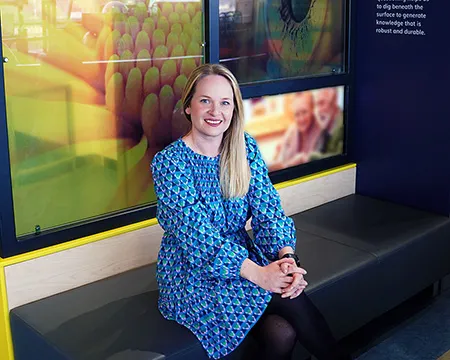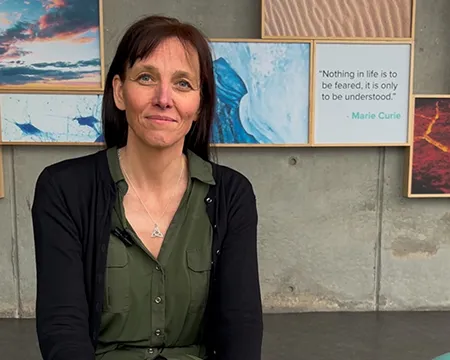Is climate change your cup of tea?

The climate crisis is impacting the amount and quality of tea that can be produced. Your perfect cuppa is at risk!
Tea is the second most consumed drink in the world with approximately half of the world population drinking it regularly. It is grown in nearly every continent on the planet. In many places tea is more than a warming beverage, it has huge cultural and social significance as well as benefits to our health.
How do you take your tea? Black? Milk and sugar, or are you sweet enough? With or without microplastics??? Glasgow Science Centre's climate change learning coordinator, Caitlin MacInnes, takes a deep dive into a cup of tea...
Jump to: A quick tea history talk | The right climate for tea production | Tea manufacture and transport | Sustainable tea | Making a cuppa (kettle, microplastics, milk) | Glasgow's connection to tea | References
A quick tea history talk
Tea is a herbal drink made from boiling the leaves of Camillia Sinensis, also known as, the tea plant. The tea plant is native to China and other East Asian countries. There is evidence of people drinking tea as early as 3AD, according to ancient Chinese medical texts. Recreational drinking of tea was popularised by the Chinese Tang Dynasty (618 – 907AD) and spread across East Asia. Portuguese priests and merchants introduced tea to Europe in the 16th century. During the 17th century, drinking tea became fashionable in England and tea planting started on a large scale in India.

Nowadays, approximately 100 million cups of tea are consumed around the UK each day. In the UK, a cup of tea usually refers to black tea served with milk and sugar. It plays a major role in the UK’s social practise and cultural identity.
Let’s explore how the climate crisis will affect something as basic as a cup of tea and understand the range of climate issues interlinked through one product.
The right climate for tea production
Tea is grown on almost every continent across the world, with the majority of the world supply originating in China or India. Tea is highly influenced by the environment it is grown in. The temperature and level of rainfall have an influence over the taste, quality and anti-oxidant qualities of the final product. Each tea contains approximately 50 chemicals which are unique to the time of year it was harvested. The climate crisis is significantly impacting the tea industry as it leads to lower yields, lower quality and threatens the livelihood of tea farmers.
About 20-30% of tea's mass is made up of chemicals known as antioxidants. These neutralise highly reactive molecules which may otherwise damage cells. The antioxidant content of tea is affected by rainfall and temperature. Antioxidant levels are higher when grown in cooler conditions with higher rainfall but the specific antioxidants present may vary.
50% of the tea grown in India comes from the Assam region. This area has experienced an overall decrease in rainfall with increased periods of drought and heavy rainfall. Periods of drought and increased temperatures don’t affect the growth or yield of tea plants; however, it does give pests more opportunity to cause harm to crops. The use of pesticides to combat this can negatively impact the crop further as they contribute to soil erosion, decrease the biodiversity of the area and may pose a risk to life if the runoff enters bodies of water. Heavy rainfall causes the soil to become clogged with water, damaging the developing roots of plants and limiting growth. Changes to the timing of seasons is creating a shorter window of time in which tea can be grown and harvested, limiting the amount grown.

In order to grow the amount of tea needed to meet global demand, large areas of land are being deforested and turned into monocultures which reduced the local biodiversity and lowers the quality of the soil. In the face of this, tea farmers are increasingly using practices to preserve the soil such as mulching and using drainage ditches. One climate adaption being trialed is agroforestry. This method involves the tea plants being grown in a forest environment alongside other species of plants and trees. It provides the tea with additional shade and protection from frost as well as reducing moisture loss and soil erosion.
Tea can be successfully grown alongside rubber, which is also extensively cultivated in China, as they have complimentary water uptake patterns meaning that they share resources effectively. In Sri Lanka, the fourth largest tea producer in the world, there are projects trialing tea and coconut plantations to improve the quality of the soil and ensure the sustainability of both crops.
Tea manufacture and transport
Before the harvested tea leaves become the “tea” product we know it must be dried and packaged. The process of drying tea is reliant on fossil fuel-based energies which contributes to harmful greenhouse gas emissions.
The dried tea can then be packaged. 96% of tea drinkers in the UK use teabags. These can be made of natural or synthetic fibers and may be sealed with glue. Some of the leading brands of teabag contain up to 25% plastic which contributes to pollution in our environment. Many companies are trialing bio-plastic seals in their teabags however, these are still considered a single use plastic. If a teabag contains any plastic, it cannot be composted. Tea bags themselves can be made from cotton, paper, synthetic fibers or a blend, each with their own environmental impact.
Approximately 18% of the total global greenhouse gas emissions are associated with producing food (or consumables like tea). Transport of food accounts for only 6% of that total. It’s more impactful to address the issue of food waste, which accounts for 6% of all global greenhouse gas emissions – which sounds small but that is nearly one quarter of all the food related emissions.
Loose leaf teas are a more environmentally-friendly option as there is less packaging and the leaves can be composted after use. Because of the larger leaf size, loose leaf tea tends to be of a higher quality.
Sustainable tea
These adaptions are reliant on the people growing tea having the adequate resources and support to do so. Many of the people who grow and harvest tea are subject to various labour and social injustices as the industry is rooted in colonialism and racism. To ensure that tea is grown in fair and environmentally friendly conditions there are globally recognised certifications that can be obtained. Approximately 17% of tea drunk around the world is certified by The Rainforest Alliance, Fairtrade or organic. However, 80% of tea products in the UK are certified by at least one of these schemes.
The Rainforest Alliance conduct annual audits of tea farms to ensure that they are using environmentally friendly practices and providing safe and fair working conditions. They also support farmers to build resilient, sustainable businesses whilst respecting the land and workers' rights. If a tea is certified by The Rainforest Alliance it will display their frog logo on the packaging.

Fairtrade certification ensures that the farmers and people who work within the tea industry make a fair wage in safe conditions. The farmers are also supported to ensure their business and practices are resilient enough to face the challenges presented by the climate crisis. Tea products with Fairtrade certification will have a portion of the cost go directly towards the programmes that support workers.

To be a certified Organic tea product, the tea must be grown in conditions that meet EU legislation. The plants must be grown without the use of synthetic fertilisers or pesticides and should follow practices such as crop rotation, green manuring and composting. It is common for Indian teas to be grown with the use of pesticides. Due to the altitude and strains of tea that is grown in Kenya, pesticide use there is rare.
Making a cuppa
Are you using your kettle properly?
The kettle is one of the most commonly owned appliances in the UK. An estimated 97% of households own one and approximately 90% of people use their kettle at least once a day. However, the majority of people are using kettles inefficiently which has a knock-on effect to the energy industry.

The energy demand associated with using a kettle is increasing and is predicted to be attributed to 40% of the overall cooking electricity demand in the UK by 2030. The energy demand peaks and drops throughout the day which has an influence on the energy generation and distribution across the country. For example, there is a spike in electricity demand when prime time TV programmes go to an advert break known as the “TV-pick up effect”. This frequent yet intermittent use of an appliance makes it difficult to predict demand and to reduce energy usage towards more environmentally friendly targets.
On top of this, kettles are regularly overfilled which wastes both energy and money. If the UK was to boil twice as much water for every cup of tea consumed (as some figures suggest we do) we would be wasting 3,525 tonnes of CO2 per day and would cost £68million pounds in wasted energy.
The hidden danger of microplastics in teabags
A single plastic teabag can release approximately 11.6 billion microplastics into a cup of boiling water and a further 3.1 billion nano-plastics. Microplastics have the potential to do harm to our health as they are able to enter our bodies through ingestion, inhalation or skin contact and can pass into our organs and even cross the placenta into unborn babies. The specific health effects that are caused by microplastics aren’t fully understood but it is thought to be through their physical and chemical effect within the body.
Do you take milk?
Adding milk to your tea may cancel out the health benefits. Although the milk doesn’t interact directly with the antioxidants in tea to cancel them out it, tea and milk have opposite effects in the body. While not everyone is allergic to milk, it does produce an inflammatory response in the body. By adding this to your tea, you may be cancelling out the anti-inflammatory effects it has.

Glasgow's connection to tea
Sir Thomas Johnston Lipton of Lipton Tea was born and raised in the Gorbals, Glasgow. As a young boy he worked in small grocery shop ran by his parents before leaving school at 13 to support their income while taking night classes. At 15 he took a job as a cabin boy on a steamboat that ran between Glasgow and Belfast. He spent 2 years saving up for a ticket to America where he traveled across several states taking jobs as a shop assistant, in the tobacco industry, on rice plantations as a bookkeeper and accountant and as a salesman.
Lipton returned to Glasgow in 1870, an spent a year supporting his parents in their shop before opening his own the following year on Stobcross Street in the Anderston area of Glasgow. Taking inspiration from the department store he worked in whilst in New York, he opened a similar style grocer with a regular supply of high-quality items at a set price. To ensure he had the best quality at the best price, Lipton adopted a new style of doing business. He sent an employee directly to farmers and guaranteed a price for the goods he bought. It was a new way of working at the time and is how modern supermarkets work today.
The ‘Lipton’s Market’ stores began to pop up all across Scotland and the rest of Britain. Lipton’s theatrical flair and clever marketing made every shop opening an event for the local area, including giant wheels of cheese, butter sculptures and live pigs! Lipton's success hadn’t stopped his search for the next business opportunity however, which came in the form of tea. Tea was once a luxury product and very expensive to buy, but by the mid-19th century the price had fallen and it was becoming a popular drink amongst the middle class in the UK.
In 1890, Lipton travelled to Sri Lanka and bought his first tea plantation. At the time, buying tea was a bit of gamble. Sometimes it would be good, others it was bad and there was no guarantee that it would be fresh either. Lipton had the innovative idea to standardise the product so that it would always be fresh and taste the same. As his stores were being supplied by only his tea plantation, he could ensure that the tea was at a consistent quality and packaged securely to prevent mould. The tea was sold at very competitive prices due to all the production and packaging costs being controlled by Lipton’s, allowing tea to gain popularity with the working class.
Lipton now had nationally loved product and was mixing with very fashionable crowds, even royalty. In 1898 he stepped back from the business but retained controlling interest. He had made the equivalent of over a billion pounds in today’s money. Lipton Tea is now owned by Unilever and Pepsi Co and continues to sell tea products around the world. Sir Thomas Lipton died in 1931, leaving his fortune to the city of Glasgow. Various trophies he won in yachting competitions remain on display in Kelvingrove Art Gallery.
References
Our World In Data: Environmental Impacts of Food Production
NPR: Health Benefits of Tea - Milking It or Not
The Guardian: Tea is good for the heart - but adding milk to it wipes out the benefits, say researchers
Nature: How climate change might affect tea
Oxford Research Encyclopedias - Environmental Science: Cultivation, Improvement, and Environmental Impacts of Tea
Earth First: Why use an eco-friendly kettle?
The Guardian: Tread lightly: Keep your kettle in check
UK Tea and Infusions Association: Join the smart boil campaign
BBC News: Teabags - Is there plastic in yours?
BBC News: Microplastics: Premium teabags leak billions of particles - study
ACS Publications: Plastic Teabags Release Billions of Microparticles and Nanoparticles into Tea
Lipton: Tea History
BBC News: The tea tycoon who was 'the world's best loser'
NCBI - International Journal of Environmental research and Public Health: A Detailed Review Study on Potential Effects of Microplastics and Additives of Concern on Human Health
Further Information
Written by Glasgow Science Centre's Caitlin MacInnes.
This blog post is adapted from an article that first appeared in Glasgow Times in January 2022.
Our World Our Impact
Read more blog posts from the Our World, Our Impact programme team on subjects like seasonal food, outdoor play, and Scotland's rainforest.






